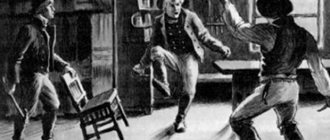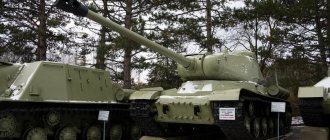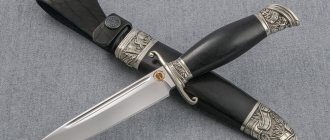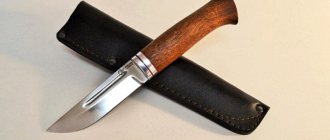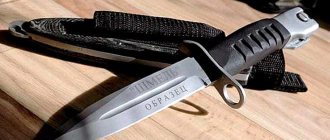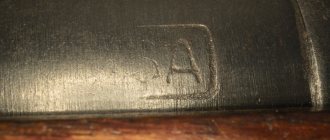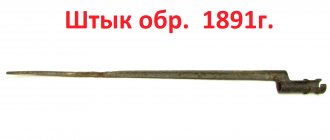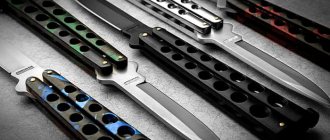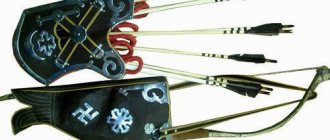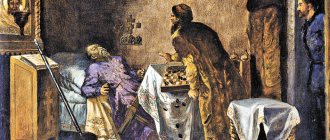Finnish knife - for most Russians of the stronger sex is known as “Finnish”. This edged weapon has been one of the legendary attributes of the male culture of the USSR and Russia over the past hundred years. Mention of this knife is found in novels, poems and songs by prominent authors: Yesenin, Vysotsky, Ilf and Petrov.
The areas of application of the knife are surprising in their breadth. Hunters and special forces fighters give the Finnish the greatest preference. The high combat characteristics of the blade also did not go unnoticed by representatives of the criminal subculture, which gave the image of the knife dangerous tendencies and informal romance.
The best Puukko models
It has already been said that the variety of knives is quite large. Today you can find many replicas of this product on the market. And the choice depends more on your financial situation. But there are also models of a traditional nature. They look quite simple, but as already mentioned, you will have to learn a special grip. There is no definite answer which Finnish knife is better. Below are several well-known manufacturers.
Knives from Roselli
Products from this manufacturer are widely known among knife lovers. Blades are made from high-carbon steel of various grades: Krupp W75, UHC, Roselli Wootz or Damascus. Workers manually bring the cutters to a razor-like state. The handles are heat treated and impregnated with linseed oil.
The product holds well in the hand and does not get cold. The rounded butt allows the use of a Finnish grip on the knife. The product is supplied with a magnificent sheath made of genuine leather.
Two knives from the Roselli company - Hunter model.
Martini Blade – Lynx Big
Cutters from the Marttiini company are highly popular and inexpensive. One of the varieties is Lynx Big, a knife released to commemorate the 110th anniversary of the founding of the company. The handle is traditionally made of Karelian birch, with a finger rest. The blade is 110 mm long, traditionally shaped, made of X46Cr13 steel, hardness HRC 56-57. Martini's Puukko knife comes with a leather sheath with a tassel at the end.
A wonderful product from Martini - Lynx Big.
Military knives from Fiskars
The company, with a history of over 400 years, produced various official models of military knives from 1919 to 1960. They are a cultural treasure of Finland and cannot be bought. Fiskars has switched to more peaceful products related to agricultural supplies. Among Fiskars knives, the most famous today is the small Fiskars K40 blade. It is positioned as fishing equipment and does not sink in water. The product shape of a traditional Puukko knife.
Use of traditional Puukko in the Red Army
The trophies produced positive results; ski squads and scouts began to arm themselves with them. Several months of combat made it clear that edged weapons were simply necessary for the soldiers of the Red Army. But you had to be able to handle a real Puukko, as mentioned above, for this you had to use a special Finnish knife grip. And there were problems with this. The Russians did not know how to hold it correctly and often injured themselves. And the command decided to develop its own version of the Finnish knife.
One of the varieties of Pukko knife.
Modern replicas
Today it is extremely difficult to buy a real NKVD Finnish car. Usually you can get such a model of bladed weapons at auctions abroad, and the cost per unit can exceed tens of thousands of dollars.
So, if you want to personally touch a piece of history, but cannot take part in the auction, you can take a closer look at the replicas, of which there are many today. There are craftsmen who make copies of such high quality that only a true professional can distinguish it from the original.
Modern replicas are produced by different manufacturers; they can differ significantly in appearance, quality and price.
Often replicas have some design changes. This is done in order to make a model that will not fall under the classification of edged weapons and put it up for free sale.
The first duplicates of the legendary Finnish NKVD knife began to be produced by the leading armory in Zlatoust. It was here that the model saw its first replica called “Finka-1”, which was produced in several modifications. If we take into account modern collectors, they prefer more modern models called “Finka-2” and “Finka-3”.
They claim that it is the second and third modifications that most accurately reproduce the original model, the very same NKVD Finnish machine made in Vacha. But despite the close similarity, the models have several differences:
- a variety of materials are used for the handle, which affects the cost;
- The thickness of the butt is 2.3 mm.
Moreover, these factory models fully imitate the original; the cost per unit ranges from 130 to 160 euros, which is at least 20 times cheaper than the original.
In addition to factory models, there are also high-quality copies that were given life by private craftsmen. The quality of such products is usually not compromised by the original ones. At the same time, the cost of such models can reach the cost of the original NKVD Finnish weapon; even experienced experts in edged weapons cannot distinguish them from such masters.
Also today there is a fairly popular folding interpretation of the NKVD Finnish. There is a characteristic red star on the handle. To throw out the blade of such a model, you need to turn part of the guard, which in itself looks quite impressive and improves the impression. Such models have the following characteristics:
- blade length – 106 mm;
- blade width – 17.5 mm;
- handle length – 135 mm;
- butt thickness – 3 mm.
Equipment
The original security officer knife came with the following kit:
- The NKVD weapon itself with a red star had several modifications. For example, today there are several models of the original gun, which differ in the type of material and color of the handle;
- sheath. They were made only from dark-colored leather with a high level of hardness. Modern modifications may have a light-colored sheath. They are easily attached to your belt using a button.
What is so special about the NKVD Finnish knife?
The NKVD Finnish knife or any other knife belonging to this category is known for its practicality and versatility. Products mainly have fixed blades, but there are also folding models. Finka differs from other knives:
- small sizes - 22-24.7 cm;
- the presence of a stop or S-shaped guard;
- a narrow blade with a beveled spine, 10.6-12.5 cm long;
- valleys running parallel to the blunt part of the part;
- a rounded or slightly curved handle with a non-slip surface and a mushroom-shaped pommel.
A traditional knife differs from a Finnish knife in that it is designed to solve narrow problems. Finnish, despite its small size, is suitable for self-defense, use at home, fishing or hunting. Design features make it safer for the owner.
The Finnish knife looks like a military weapon, although in most cases it is not. His most famous replicas belong to the category of tourist, hiking or gift items.
Blade dimensions, handle
The dimensions of the Finnish knife vary from 22 cm to 24.7 cm. The main parameter is the length of the blade, which for the classic model is 12.5 cm, but can be less - up to 10.6 cm.
The width of the part should be no more than 2 cm, and the thickness - up to 0.4 cm. This is a characteristic feature of the weapon - a narrow and short blade with a thin tip. The part is of the clip point type, that is, it has a bevel on the butt. Or is he straight? There are valleys along the butt on both sides, making the blade lighter and more maneuverable.
The weapon has a guard or, at a minimum, a limiter that prevents your hand from slipping onto the blade. Models with a bolster can be held with a Finnish grip, that is, resting on the palm. Some weapons have a “heel” in front of the guard - an unsharpened section of the blade. Thus, with a direct grip, the index finger lies on the blade, but the skin cannot be injured. But the direction of the cut is perfectly controlled.
The handle of the product was originally wooden. But modern models use bakelite and other synthetic materials. The shape of the part is round, sometimes tapering towards both edges or thickening towards the end. The pommel comes in the form of a fungus and can be made of brass or another metal alloy.
Materials
Previously, the blades of Finnish knives were made from 2-3 worn braids. They were formed into a package, that is, folded, heated, and forged into a monolithic piece. Sheets were then made from it, blanks were cut out, processed and mounted on a wooden handle.
Modern replica guns are made of high-carbon steel with a hardness of 58 HRC, with the addition of nickel and chromium. They are durable, remain sharp for a long time, and with good care are not subject to corrosion. There are also cheaper models with stainless steel blades.
The handles of souvenir knives are made of Karelian birch, animal horn, with cupronickel inserts and leather additives. The same part can be created from hornbeam with brass, a polymer material.
Is it a bladed weapon?
In the photo there are Finnish knives that are freely available (not being weapons).
The original Finnish knives are edged weapons (KW), as they have the appropriate technical parameters, which are specified in GOST R 51215-98:
- handle with finger grooves;
- blade length is more than 9 cm;
- butt thickness from 0.24 cm;
- the angle of convergence of the butt and blade is less than 70 degrees;
- the presence of a stop-limiter.
But it is difficult to find such a weapon for sale, and it is very expensive. To own, you must obtain permission. And Finns that are freely available are not XO, since their size and characteristics do not fall under this definition. Such knives are classified as tourist, camping, or souvenir knives, as stated in the certificates attached to them.
Design Features
For any bladed weapon, the main characteristic is the effectiveness of practical use. The finka is precisely the kind of weapon that can be both effective in combat and useful in everyday life. The blade of the traditional Finnish version is short and pointed on one side. However, this blade length makes it easy to use the knife for cutting branches and sharpening stakes. The product is very convenient as a kitchen utensil and can be used for cutting game. The blade is equipped with a thick spine, which allows you to apply additional physical force. The block or handle of the finka can withstand a blow from a log or a hammer to the butt.
For the manufacture of knives, weapon steel with a hardness of 58 units on the Rockwell scale is usually used. A Finnish hunting knife, made using traditional ancient technology by Finnish blacksmiths, is made from a worn-out scythe. The metal in this case is soft and ductile, amenable to cold forging. The manufacturing technology of traditional Puukko-Finnish knives was as follows:
- worn-out braids are collected in a bag (2-3 pcs.);
- when heated, the package is forged until monolithic bars are obtained;
- the finished bars are riveted into narrow thin metal strips;
- then pieces of steel are cut to fit the size of the blade;
- the strip is forged and turned to the shape of the blade and shank;
- the handle is mounted on the blade.
Today, for the manufacture of various versions of Finnish knives, high-carbon steel is mainly used, where nickel and chromium are present as alloying additives. Nickel increases the metal's resistance to corrosion, and chromium makes the material more resistant. In ancient recipes for making Finnish knives, they tried to use durable steel. Today, the edged weapons market is dominated by cheap grades of steel, which are used for the mass production of knives of dubious quality.
High-quality steel allows the blade to maintain its sharpness for a long time. Proper and competent care of the blade will prevent rust from occurring.
How did a puukko utility knife turn into a gangster finca?
Before the revolution in the Russian Empire, no one considered carrying a knife as something criminal. On the contrary, Russian traditional culture assumed the constant carrying of a knife, especially among peasants. With the Bolsheviks coming to power, everything changed; in 1927, the first bans related to knives appeared. In the early 1930s, a massive campaign began to ban all knives except kitchen knives, the echoes of which resound in the minds of ordinary people even today.
In 1932-33, a series of publications appeared in which various bandits and kulaks brutally dealt with representatives of the Soviet government with knives. Finnish knives were clearly mentioned in the articles, since these were the knives most often used by professional criminals of those years.
History of classic and traditional knives of pre-revolutionary Finland
Before Finland came under the rule of the Russian Empire, it belonged to Sweden. It is not surprising that traditional Swedish and Finnish knives have many similarities.
Finnish puukko knives first appeared in the Bronze Age, and even before that there were bone knives of a similar shape. The word puukko means “knife with a wooden handle,” and all other theories about the origin of this word are nothing more than fiction. The word puukkojunkkari, which means knifeman, appeared thanks to puukko, and not vice versa.
The authorities of Sweden, and later the Russian Empire, tried to disarm the Finns as much as possible, since the accumulation of a large number of weapons, and even more so the development of national knife traditions, was absolutely of no use to them. However, they could not ban traditional knives, which were more like household tools, so in the 18th century many varieties of the puukko knife appeared, which local residents learned to wield masterfully.
In the 18th and 19th centuries, a popular liberation movement gained strength in Finland, the participants of which were experienced knife fighters. Since these were the sons of wealthy farm owners, their knives were made of higher quality steel and had stacked handles.
At the beginning of the 20th century, Russian hunters began to take a serious interest in Finnish knives, which were most common among the indigenous inhabitants of Finland. Russian craftsmen began to copy puukko, and the copies were made according to drawings and had the same dimensions and appearance. Knives by master Lisakki Järvenpää were specially supplied for the imperial palace.
DIY Finnish puukko knife
Before making a puukko, you need to sketch out a drawing of the future knife with the dimensions of the handle, blade, thickness, and additional parts. After this, the sketch of the blade is cut out and applied to a steel workpiece, outlined, then the long and labor-intensive process of cutting out the workpiece begins. You can use any convenient tool for cutting metal - sandpaper, file, grinder. After the workpiece is cut, you need to drill a hole for the rivet at the end of the shank; this can be done with a Pobedit drill. You can immediately make a rivet: take a brass rod with a diameter slightly smaller than the drilled hole.
Next, the blade slopes are formed. Using an emery machine, the blade is sharpened so that the slopes are brought to zero. When drawing out the slopes, you need to make sure that they are the same on both sides. At this stage of manufacturing, it is possible to make teeth on the shank, allowing the handle to be firmly fitted in the future.
The blade is polished with a medium-coarse whetstone, and the cutting edge of the product is formed using a whetstone. Work with the blade is completed by sanding it with felt. The sleeve is made of 3mm brass:
- A sketch of a sleeve with a groove is applied to the plate
- Using a drill with a 2 mm drill, several holes are drilled in place of the groove and then drilled out.
- Using a hacksaw, the shape of the sleeve is formed, which is inserted onto the shank and sealed on both sides.
Next, the handle is made. It can be done in a simple or labor-intensive way, depending on personal preference. The simple way is as follows:
- You need to take a birch beam, drill a hole in it for attaching the blade, as well as a hole for the rivet.
- Using epoxy glue, the blade is glued inside; after the glue dries, the shape of the handle is formed using sandpaper.
- Next, the handle is fixed at the rivet site with a brass rod and polished on a special machine.
- The made handle is impregnated with beeswax, linseed oil or a special paste.
Origin of the Finnish woman
Despite the fact that the finka is a traditional domestic type of bladed weapon, Finnish craftsmen are still considered the ancestors of the knife. The popularity of the knife in Russia is explained by the fact that Finland was considered a part of the Russian Empire for a long time. Many Finnish traditions, including in the field of weapons, have become widespread in Russia. The prototype of this weapon can be considered the traditional Finnish hunting knife “puukko”, which was successfully used on the farm and in the field. For hunters and fishermen, such a knife was a must-have in the arsenal. The spread of knives of this type was facilitated by their simple design and versatility.
The name is most likely a collective one. Translated from Finnish, “puu” means “tree,” but the second part of the word, “pook,” in one of the German dialects means a knife. Traditionally, a Finnish knife is considered a handmade product. It had a small, sharp, straight blade with fullers. The thick butt and massive handle ensured a comfortable grip and effective use of the knife.
Finnish gunsmiths continue to produce exclusive products that have retained their original shapes, sizes and qualities. Most versions of the knife that appeared later became modernized and improved varieties of this knife. The Russian version is the most widespread. First in the Russian Empire, and later in the USSR, knives of this type began to be widely used as military weapons. The main domestic version was the NKVD knife - a special combat weapon. Subsequently, on the basis of this modification, an army version was developed and created - the HP-40 knife, which entered service with the Red Army.
What prompted the creation of scout knives?
The emergence of various types of firearms and equipment gradually relegated knives to the background, and this clearly affected the equipment of the Soviet troops, and in the most unfavorable way.
It became characteristic that by the 40s of the last century (or rather, during the period of hostilities between the Soviet Union and Finland in 1939), there was no standard knife for equipping a Soviet soldier (the bayonet that was attached to the Mosin rifle does not count: it was intended only for stabbing wounds). At the same time, the soldiers certainly needed an assistant: to cut bread, trim wood, cut rope and for many other needs, not excluding, of course, one of the main functions - self-defense, protection from the enemy.
The direct opposite was the enemy’s combat arsenal - Finnish soldiers, especially those who went on reconnaissance missions, had to have edged weapons.
The leadership of the Soviet Army, taking into account the unpleasant results of military clashes with the Finns for our side, came to the conclusion that soldiers, in particular those performing reconnaissance operations, needed to strengthen their combat arsenal. Consequently, it was decided to add one more component - a special reconnaissance knife, and the blade, which was used by the enemy, became a completely suitable idea for the development of the first Soviet reconnaissance knife, HP-40 (the digital indicator in the stamp indicates the year of manufacture - 1940).
Is it possible to make a Finnish NKVD knife 1935 with your own hands?
The product can be made with your own hands so that you get an NKVD Finnish knife from 1935: you need to have a sheet of good steel, for example, grade 95X18, for the handle - a wooden block, and the guard and pommel are made from pieces of brass. You will need a set of discs of different diameters and with belts of different abrasiveness, a vice, and welding. The whole process consists of several stages:
- A drawing is made on paper or cardboard, possibly in two projections.
- On its basis, a cardboard template of a blade with a shank is cut out.
- It is fixed on a steel sheet, outlined and the workpiece is cut out along the lines using a disk machine.
- It is leveled using a flat grinder.
- Using a disk, draw a valley along the butt.
- The runs are made on a large disk with a diameter of 40 cm using a coarse 40-N abrasive.
- The next stage is hardening the blade in a forge, followed by cooling in oil and tempering.
- The bevels and blade are treated with a finer grit disc to level and polish.
- The final polishing of the blade is carried out first on a disk with a 4-N fine abrasive tape, and then on felt and GOI paste.
- The finished guard and butt are processed on a milling machine so that they fit the size of the blade and tang.
- The working part of the blade is wrapped with masking tape.
- A polished guard is placed on the shank.
- Holes are made in it for fastenings for a rod with a thread for a nut; it can also be welded.
- To make the handle, a birch block is turned and polished.
- A hole is made in it with a diameter corresponding to the thickness of the shank.
- In a small container, mix epoxy resin with hardener.
- The composition is coated with the place where the blade connects to the guard, the rest of the liquid is poured into the hole in the handle blank.
- The shank is also inserted there; its threaded tip should stick out from the other side of the wooden block.
- A nut is screwed onto it to secure the structure.
- The nut and pin are covered with a brass cap, which will be held in place by the epoxy mixture.
- The knife is placed in a vice and left to dry for a day.
- The handle is ground on a Grinder machine using sandpaper.
- To ensure smoothness, it is sanded by hand, clamped in a vice.
- The pommel is polished, including using GOI paste.
- The wooden part of the handle is treated with beeswax.
Watch the video of the complete production of the “NKVD Finka” knife:
Types of Finnish hunting knife Puukko
The variety of cutters is amazing. They are divided by purpose, regions of the country and in accordance with historical events. Quite a complex classification structure. The process of making a cutter is inherent in every Finnish family. It seems that even a child can make a Finnish hunting knife. It is rare to find peoples capable of preserving centuries-old traditions.
Products with interesting names
The names of these knives carry a piece of historical event. Or the blade was dedicated to a famous person. They have external distinctive features, but belong to Puukko knives:
- A product that does not have the official status of weapons of the Finnish army. Manufactured during the Soviet-Finnish War and World War II, it has the name Sotapuukko. It is slightly larger in size than a typical Finnish hunting knife. Some blades bear the names of the owner's units. The scabbard was made from the aluminum skin of enemy aircraft.
- An interesting specimen that belongs to the collection models is Olympia. They were produced for the failed 1940 Olympics. Similar products were produced in 1952, again in honor of the Olympic Games.
- Today's attribute of the Finnish national army is Svinhufvudin. Acquired a name in honor of one of the country's presidents. He always carried a similar cutter with him.
- A popular product among American soldiers during the war in Vietnam was Vietnamin puukko. It looks like a survival knife with a saw on the butt and a spear-shaped blade. A pronounced guard and a hollow handle are evident. Its dimensions are large for a Puukko knife, but it is one.
- A well-known model is Wirkkala puukko. The cutter is named after its designer. The knife has been produced by several companies since the 60s of the last century to this day.
- A peculiar guard of Finnish hunting knives - Lynx. It has a traditional shape; translated it means lynx. It has been produced for quite a long time and continues to this day.
- A popular bayonet model is the Sissipuukko. The creator of the product is Finnish officer Peltonnen. Gained popularity among fans of military weapons.
There are many more models in reality. And this pleases buyers and collectors. But it is unlikely that it will be possible to completely collect all varieties.
Varieties according to regional characteristics
A similar division is present in the regional production of knives. This is due to the customs of local residents, who have been passing on the skill of making cutters for centuries. Let's look at some of them:
- visually attractive blade - Vöyri puukko has a brass bolster and pommel of the handle. On some specimens the handle is made entirely of metal. The brass-finished steel sheath and the product itself look quite attractive. A Puukko knife of this model is often used as ceremonial uniform;
- The Finnish municipality of Kauhava produces knives - Kauhava puukko. But there are a lot of manufacturing companies there. It is easy to find cutters with the same name, but they will look different;
- a simple working cutter – Jalasjärvi puukko, there are no frills in the form of brass decorations. Its special feature is its unusual sheath. They bend at the very tip;
- but the product - Kalajokilaakso puukko, on the contrary, has a chic decoration of the hilt and sheath. Such specimens are classified as collectible and gift models.
A collectible item from Finnish craftsmen.
Each cutter is unique in its own way. The products are really beautiful and, in addition, functional. But some of them will feel awkward picking or whittling a log, and you shouldn’t even think about the loafing - your heart won’t be able to stand it, for fear of spoiling such beauty.
Division by purpose of instruments
For every cutter, its practical application is important. In everyday life, hunting or fishing, Puukko knives perform well
But for each manipulation there is its own product model. Consider the table below:
| Knife name | Purpose |
| Metsästyspuukko | Universal knife for hunting |
| Vaarinpuukko | Small hunting knife |
| Eräpuukko | Large hunting cutter |
| Yleispuukko | Carpentry work |
| Vuolupuukko | Wood carving |
| Avauspuukko | Small game dressing |
| Nylkypuukko | Skinning tool |
| Partiopuukko | Tool for beginners |
| Fileerauspuukko | Sirloin cuts |
| Pikkunikkarinpuukko | Children's version of the knife |
Yes, Finns are taught to use a cutter from childhood. This is normal for them. In the country of the Soviets, every street boy had a small pocket in his pocket, but times and customs change, and cutters were replaced by telephones.
Varieties
Classic Finnish puukko are divided into groups based on their main purpose. However, their configuration is almost identical:
- a knife with a soft curved spine, a short blade - for working with wood;
- model with a wide blade – hunting.
Another national Finnish knife is the leuku. This is an invention of the Sami people living in Lapland. If puukko, according to modern classification, can be classified as every day carry, then leuku is a camp or bivouac knife, a kind of cleaver that can easily replace a small hatchet. In terms of dimensions, it is approximately twice as large and, accordingly, much heavier.
The Sami knife is intended mainly for rough work - cutting stakes, chopping wood chips. It is very similar in configuration to puukko. But the dimensions determine the greater thickness of the blade. And the top of the handle is symmetrically mushroom-shaped so that it does not slip out of the hands during strong chopping blows. A distinctive decorative element is the tip on the scabbard made of deer antler.
In modern Finland, knives are produced by large brands and private workshops. The appearance of the puukko continues to undergo changes, but not dramatic ones. The main attention is paid to decorative elements on the sheath, blade, and handle.
Among the new models we can mention:
- fishing - with a rubber handle and a file for removing scales;
- hunting - with a handle covered with Teflon, which does not slip in the hand when skinning or cutting meat;
- knives for mushroom pickers – classic shape and small size.
The most expensive models, of course, are made by hand, in a single copy. Such exclusive knives are intended mainly for collectors. They often have a Damascus steel blade and characteristic decorative features - the Finnish coat of arms or a knob in the shape of a partridge. Production models have a stainless steel or carbon steel blade and a diamond edge for sharpening.
Leuku
Puukko
Finka is not just an ordinary knife, it is an extension of a human limb
The main advantage of the knife is its versatility. The knife cannot boast of large dimensions, it is very simple, but despite this, it can be used to cut tree branches, cut bread, sausage, butcher game, you can even open canned food and bottles. If the Finnish woman is real, you can safely hit her thick butt with a hammer. Finnish hunting knives are very strong; Finns used them to do any work. They could remove splinters, crush ice, shave, repair household items, equipment and other gear. The knife is so comfortable that you don’t even want to let it go – the handle naturally fits into the palm, as if it were an extension of the limb. Even the very contemplation of a blade can awaken the hunter's instinct. Primitive man would not have survived without such a knife. As for more refined models (decorated with notches, etched), they are perfect for collectors.
Summing up
An unpretentious and simple cutter in appearance, it is quite suitable for performing many tasks. The Puukko knife attracts with its simplicity. A wide range of varieties will allow you to choose a product to suit your taste. When choosing a product, you should think about what kind of work it will perform. If there is no specific goal, there are universal models. There are a lot of fakes floating around the world, be careful when choosing.
Previous
Ancient knife skramasaks: history, descriptions, types
Next
Ancient HOUnderside knife
Finnish knife in folklore
Finka, like any other household item, has found its place in the customs and folklore of the people. In Karelia, all girls for a certain period of time wore an empty knife sheath on their belt. The guy who wanted to marry the girl inserted his knife into her sheath. If at their next meeting his Finnish knife remained in the sheath, it meant that he was a desired groom. This was a special sign, after which the guy could send matchmakers to the girl. If a girl took the finca out of its sheath, it meant that she did not want to marry this guy.
In the Far North, men also had their own customs. If a man worked in the forest for a very long time and had to spend the night there, he stuck a knife into the wall above him, thus protecting himself from evil spirits. A similar thing was done in houses, people stuck a knife over the door, as if blocking the path for all evil spirits. In addition, there was another custom: if a baby in the house began to cry, a knife was inserted just above the door.
The invention of the knife can be put on a par with the achievements of primitive man: making fire and taming domestic animals, since with the advent of the knife, people’s lives became much simpler, obtaining food became an easy matter, and people were able to defend themselves from wild animals and invader tribes.
Knife for the king
Externally, the puukko has changed somewhat over time, acquiring decorative elements. Making a more or less decent knife requires the talent of a blacksmith, jeweler, tanner and carpenter; The Finns learned this 150 years ago at the best English and Swedish factories.
Puukko is produced in Finland by numerous private craftsmen and small firms throughout, but some regions, such as Pohjanmaa, especially the Kauhava region, are especially noted for this: after World War II, 26 of the 30 largest Finnish puukko producers were located here. The most expensive knives are still made by hand, but their industrial production also has a long tradition.
Thus, the famous kauhava-puukko knives are produced at the factory founded in 1879 by master Iisakki Järvenpää. Almost without funds, having only a passionate desire to make beautiful knives, learning how to forge and harden steel on the go, the twenty-year-old youth set to work alone in his cramped barn. The creator of a new, artistically decorated puukko, he was the first to make handles from birch bark, inlay them with copper and silver, and decorate the scabbard with bronze and brass.
In 1888, he made a knife for the heir to the Russian throne, Nikolai Alexandrovich; Since 1890, 10 people had already worked with him, and in 1894 he made a second knife, this time for Emperor Nicholas II, which was certified by the highest diploma. In 1922, more than 25 craftsmen already worked at the factory; Today it is the largest production facility in Finland, producing only Finnish knives.
In total, about 150 companies and private individuals entered into the history of Kauhava, one way or another connected with the production of puukko. The second largest knife manufacturer - - focuses on the traditional design of Finnish knives.
Despite its advanced age, the Finnish knife was able to prove its usefulness in our technologized world.
//
Recommendations
The price of replica NKVD knives on the modern market ranges from 150-200 dollars (9-12 thousand rubles). The final cost is affected by age, equipment and material of manufacture. Early copies are valued higher, as they are considered to closely imitate the original finca. Initially, the blade in question belonged purely to specialized military weapons. Now such products are usually positioned as collectible or souvenir exhibits. It is recommended to purchase the original in the presence of an experienced antiquarian. It will help not only determine the authenticity of the model, but also its real value.
History of creation
The prototype of the Vachin finka was the national Finnish blade, known as the “pukko”. Over time, the Soviet version of the knife improved, acquiring specific characteristics that the Scandinavian ancestor did not have. The official history of the existence of Finnish women ended in 1935, when the carrying, manufacturing and sale of this type of bladed weapon was banned at the legislative level.
The original Vachin finca was designed and created in the 30s of the last century. The model was made for special units of the NKVD, which needed reliable and compact combat knives. Schemes and drawings were created on the basis of short Finnish national knives, which were designed by Pontus Holmberg. Since the creator was from Sweden, the blades were initially classified as the “Norwegian” type of blades.
Features of the national knife Puukko
The design of the Finnish Puukko knife itself, as already mentioned, is quite simple. A straight and short blade with a fairly thick spine of 5 mm. The handle is uniform and does not have any anatomical grooves or cutouts. And it is larger in size than the blade itself. Briefly it can be characterized by the following features:
- the blade had a length of 10-15 cm, but usually something in between 12-13 cm;
- the wood from which the handle was made was impregnated with oil or paraffin; the material was usually Karelian birch;
- there was a fitting at the entrance of the blade into the handle;
- the blade had a Scandinavian bevel with a straight spine without fullers;
- The handle is barrel-shaped, with a slight bend at the end.
Finnish national knife Puukko.
There are even drawings of the Finnish Puukko knife. You need to hold it in a special way. The handle must be rested in the palm of your hand and held with three fingers; the other part is held with the remaining two fingers. This holding method is called the Finnish grip. The method takes time to learn. But having learned to hold it correctly, it becomes a formidable weapon, self-defense or attack.
Finnish knife blades
The length of the blade, as already mentioned, is quite small, only 10 cm. Sometimes they were found with fullers on the blade. The dol must be forged, and not just cut out with a grinder. Otherwise it loses all meaning and weakens the blade itself. But this is rather a trend of modern, more fashionable options. Making a fuller on a blade 10-12 cm long is absolute stupidity. Some fans call it “bloodstock”, but this is incorrect.
The descent on the blade began approximately from the middle, thanks to which it had an excellent cut. Sharpening such a blade was not difficult. The decorations on it have never been done before. Again, in more modern replicas, you can see a decorated hilt or the blade itself. According to some reports, jewelry began to appear in 1880, but was quite rare.
Handle and sheath of Finnish knives
The handle is usually made of wood. For reliability, use the root part of the tree. In modern replicas you can also find plastic, but to be honest, in this design, this is far from a Finnish Puukko knife. Most often, swamp birch was used to make the handle; in our country it is known as Karelian. Again in a modern design, exotic trees and inserts made of copper, bone or horn are often used.
Finnish Puukko knife and case for it.
Separately, I would like to talk about the sheath of the Puukko knife. In the 19th century, craftsmen began to paint them in different colors. Until then, the sheath was woven from birch bark or simply made of wood. But today they have truly become a work of art. Many craftsmen try to approach this matter quite creatively. It also happens that a simple, inconspicuous-looking blade has a beautiful sheath.
Price of Finnish Puukko knives
The cost of products depends on: the grade of steel used in manufacturing, the total size of the product and the company that produces the cutter. The leather sheath adds considerable cost. Some of the most expensive knives are made of Carbon steel; the handle is traditionally made of Karelian birch. Prices for decent Puukko products range from 5-9 thousand rubles. Collectible models will cost more from 15 to 60 thousand.
Russian Finnish woman and her features
When the conversation starts about the Russian Finnish knife, you need to understand that we are talking more about the HP-40 scout knife. And it was already quite noticeably different from the real Finnish Puukko knife from Finland. They began to use this modification in the 40s. The differences can be briefly described as follows:
- obvious guard on the blade, S-shaped;
- the bevel on the blade has moved closer to the end;
- the knife itself has increased in size;
- the handle acquired anatomical characteristics.
Replica of the Russian Finnish Red Army.
But during the Great Patriotic War, the soldiers of the Finnish army must be given credit for their ability to work more efficiently with their knives. And they armed themselves only with their national Puukko; they did not need any other modifications.
Classification of the Finnish hunting knife Puukko
The puukko hunting knife comes in several subspecies, they are combined:
- by purpose - you can deal with wood, game, meat, fish, and perform other work in the forest;
- by regions of the country in which they are produced;
- in connection with the historical events that caused the creation of the weapon or accompanied it.
By purpose
There are many varieties of puukko according to their areas of application:
- Yleispuukko – for carpentry work;
- Vuolupuukko – for wood carving;
- Eräpuukko – large hunting bird;
- Vaarinpuukko – small hunting dog;
- Metsästyspuukko – universal for hunting;
- Avauspuukko – for cutting fish, poultry, small game;
- Nylkypuukko – for separating animal skins;
- Fileerauspuukko – for cutting fish into fillets;
- Pikkunikkarinpuukko - almost a toy for children with a guard and a rounded tip;
- Partiopuukko is a scout's weapon.
1 of 8
Yleispuukko Vuolupuukko Eräpuukko Vaarinpuukko Metsästyspuukko Avauspuukko Nylkypuukko Partiopuukko
Historical and regional varieties
Puukkos made in different regions of Finland also have differences:
- The Vöyri puukko knife has brass inserts on both ends of the handle. Sometimes it was made entirely of this material, and wood was not used. The gun was more like a Swedish one. Another feature is its symmetrical scabbard, also finished in brass. Due to its striking appearance, the Vöyri puukko was used as a ceremonial weapon.
- Jalasjärvi puukko. Unlike its previous brother, this is a simple working knife. Its peculiarity is the scabbard that bends at the tip. But the blade was of a traditional shape.
- Kalajokilaakso puukko. This weapon is more richly decorated than other models. The decor of the scabbard is especially bright.
- Kauhava puukko. The name, as in previous cases, comes from the name of the area. But there are many companies in Kauhawa that produce these knives. And therefore, tools with this name may be different from each other. For example, one is distinguished by a pommel in the shape of a mushroom cap, the other is decorated with a dog’s head. The blades may have inscriptions and images etched on them, which is not typical for other types of puukko.
- Harma puukko. This is a simple knife, very convenient for self-defense. It has a handle with a collar that continues the line of the butt. And on the opposite side of the part there is a comb that makes it easy to feel the weapon in your pocket and take it out without looking.
1 of 4
Knife Vöyri puukko Kalajokilaakso puukko Kauhava puukko Härma puukko
These are the most common types of puukko, but besides them there are also:
- Pekanpaa,
- Toijala,
- Kainuu,
- Rautalammi.
All of them are named after the areas where they are made.
